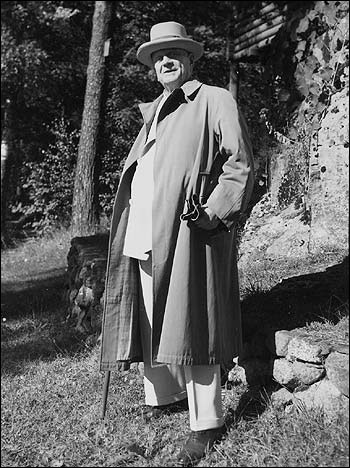Jean Sibelius (1865-1957)

Jean Sibelius lived at Ainola from the autumn of 1904 until his death. He felt that the best environments for writing music were either big cities or the quiet of the countryside. "Here in Ainola the silence speaks," he said in his only radio interview, given in 1948.
For Sibelius the move to Ainola meant getting away from the temptations of Helsinki. However, Ainola was not without problems as a working place: the times when Sibelius was able to work in peace were mainly at night, or else in the summer when the rest of the family had gone to Lohja. The situation improved slightly in 1911, when the upper floor became habitable and the father of the family obtained a quiet study.
The family did their best, and the children were taught to be quiet whenever their father appeared to be composing. Indeed, symphonies 5-7 were written almost entirely at Ainola. However, Sibelius wrote parts of the third symphony in Paris and Berlin, parts of the fourth symphony at the Hotel Fennia in Helsinki, parts of the string quartet Voces intimae in London and parts of Tapiola in Rome.
In his old age Sibelius often laughed at his American guests who expected to see a castle but entered a "humble home" instead. Sometimes the composer himself told interviewers that he wished that the lake view from his small study were grander. However, he consoled himself with the idea that "small rooms generate great thoughts, whereas great thoughts may shrink in large rooms."
At Ainola, the composer experienced many of the best moments of his life: his masterpieces were completed there, his family grew up there and the weddings of his daughters were celebrated there. During the last decades of his life Sibelius's fame brought to Ainola some of the world's best musicians as well as other notable individuals. By then, Sibelius had no wish to leave the place.
However, Ainola had actually been a prison for Sibelius during the First World War, when he would have wanted to conduct his music abroad. Even later on there were problems: the tremor in his hands forced him to give up public performances, and he was never able to create a satisfactory version of his eighth symphony, a work which he had written at Ainola. However, Sibelius believed that sorrows were an essential part of life and that they made it richer.
"It is sorrows that make a home. All the difficulties which we must overcome together with our family in the course of a long life create a love for home," Sibelius said.
Jean Sibelius died of a cerebral haemorrhage in his beloved Ainola on 20th September 1957.
Read Jean Sibelius's Memories of Ainola

































